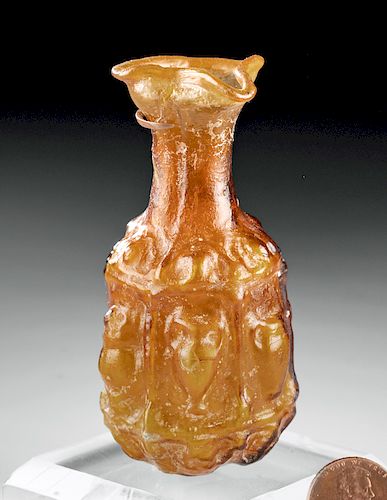Miniature Roman Sidonian Glass Bottle - Amber Hue
Lot 89
About Seller
Artemis Gallery
686 S Taylor Ave, Ste 106
Louisville, CO 80027
United States
Selling antiquities, ancient and ethnographic art online since 1993, Artemis Gallery specializes in Classical Antiquities (Egyptian, Greek, Roman, Near Eastern), Asian, Pre-Columbian, African / Tribal / Oceanographic art. Our extensive inventory includes pottery, stone, metal, wood, glass and textil...Read more
Categories
Estimate:
$4,000 - $6,000
Absentee vs Live bid
Two ways to bid:
- Leave a max absentee bid and the platform will bid on your behalf up to your maximum bid during the live auction.
- Bid live during the auction and your bids will be submitted real-time to the auctioneer.
Bid Increments
| Price | Bid Increment |
|---|---|
| $0 | $25 |
| $300 | $50 |
| $1,000 | $100 |
| $2,000 | $250 |
| $5,000 | $500 |
| $10,000 | $1,000 |
| $20,000 | $2,500 |
| $50,000 | $5,000 |
| $100,000 | $10,000 |
| $200,000 | $20,000 |
About Auction
By Artemis Gallery
Sep 26, 2019
Set Reminder
2019-09-26 10:00:00
2019-09-26 10:00:00
America/New_York
Bidsquare
Bidsquare : Exceptional Day 1: Antiquities & Asian Art
https://www.bidsquare.com/auctions/artemis-gallery/exceptional-day-1-antiquities-asian-art-4437
Day 1 of an important 2-day auction featuring exceptional, museum-worthy examples of Egyptian, Greek, Etruscan, Roman, Viking, Russian, Near Eastern, as well as Asian Art from China, Japan, Thailand, Vietnam, Burma and India. Artemis Gallery info@artemisgallery.com
Day 1 of an important 2-day auction featuring exceptional, museum-worthy examples of Egyptian, Greek, Etruscan, Roman, Viking, Russian, Near Eastern, as well as Asian Art from China, Japan, Thailand, Vietnam, Burma and India. Artemis Gallery info@artemisgallery.com
- Lot Description
Roman, Sidonian, ca. 2nd to 4th century CE. A stunning miniature mold-blown glass vessel, the globular body presenting 6 panels, each one adorned by an amphora in relief, with leaf forms adorning the shoulder above as well, followed by a long tubular neck resolving to a trefoil rim - all upon a carinated/ribbed lower section above a ring base and delineated in stunning amber hues with tinges of auburn red hues in areas. In addition to its gorgeous hues, the glass presents marvelous translucence and areas of iridescence when held to the light. A lovely unguent or perfume bottle of an attractive form, quite refined and presenting exquisite detailing. Size: 3.25" H (8.3 cm); 3.875" H (9.8 cm) on included custom stand.
Sidon was a center of art glass production in ancient times. Here are Pliny's words as he described his voyage to Sidon, "From this point on we must go back to the coast and to Phoenicia. There was formerly a town called Crocodilian, and there still is a river of that name … Then comes Cape Carmel … Next are Getta, Geba, and the river Pacida or Belus … Close to this river is Ptolemais … Next Tyre, once an island separated from the mainland by a very deep sea-channel 700 yards wide, but now joined to it by the works constructed by Alexander when besieging the place … but the entire renown of Tyre now consists in a shell-fish and a purple dye! … Next are Zarephath and the city of birds (Ornithon oppidum), and Sidon, the mother-city of Thebes in Boeotia where glass is made." (Pliny, Natural History V.75-76, 77-79 AD).
Provenance: private East Coast, USA collection; ex-private Israeli collection, acquired in 1980's
All items legal to buy/sell under U.S. Statute covering cultural patrimony Code 2600, CHAPTER 14, and are guaranteed to be as described or your money back.
A Certificate of Authenticity will accompany all winning bids.
We ship worldwide and handle all shipping in-house for your convenience.
#147861Section of the rim has been repaired, but professionally done and difficult to discern unless held to the light. Traces of surface deposits/weathering film commensurate with age and exposure.Condition
- Shipping Info
-
All shipping is handled in-house for your convenience. Your invoice from Artemis Gallery will include shipping calculation instructions. If in doubt, please inquire BEFORE bidding for estimated shipping costs for individual items.
-
- Buyer's Premium



 EUR
EUR CAD
CAD AUD
AUD GBP
GBP MXN
MXN HKD
HKD CNY
CNY MYR
MYR SEK
SEK SGD
SGD CHF
CHF THB
THB












